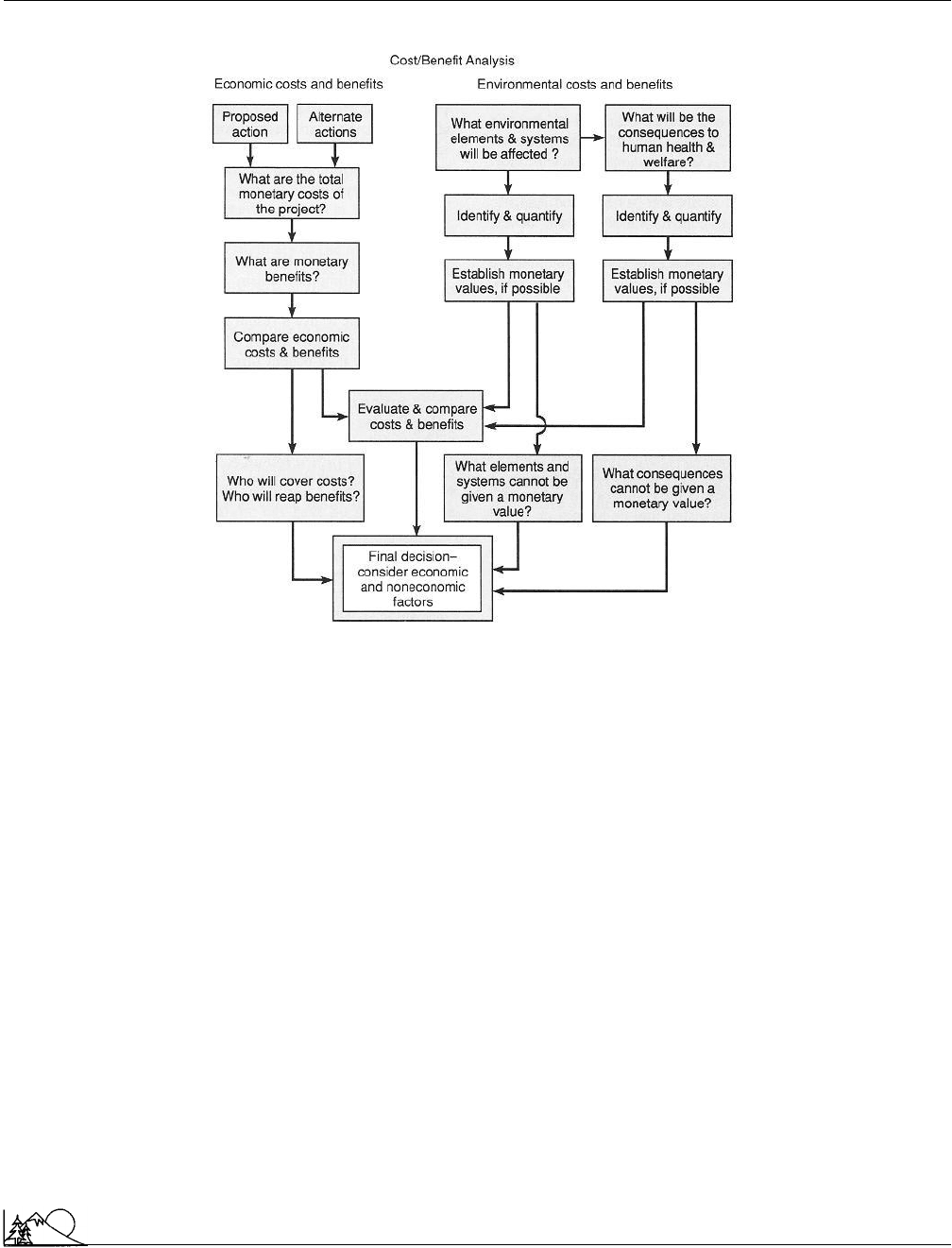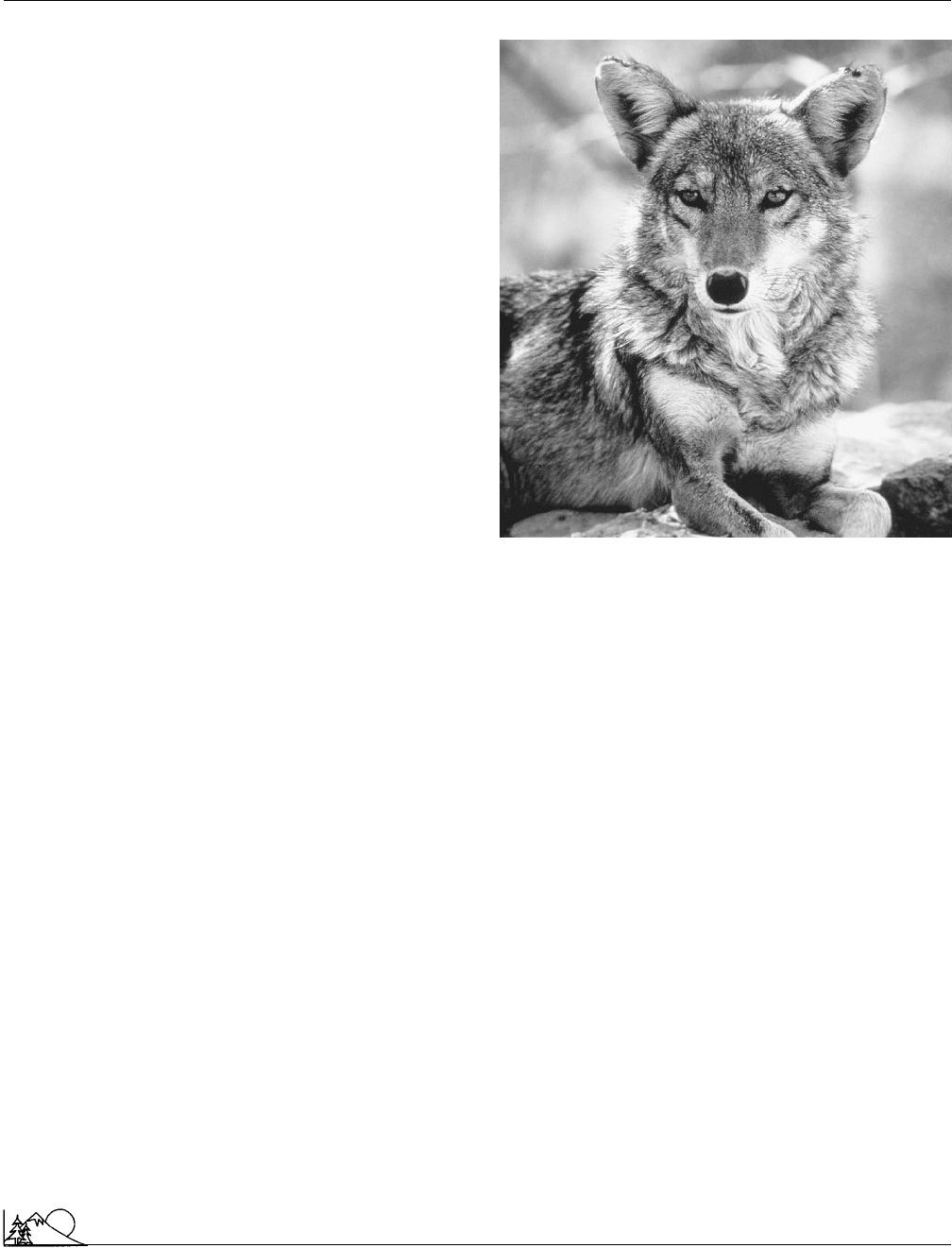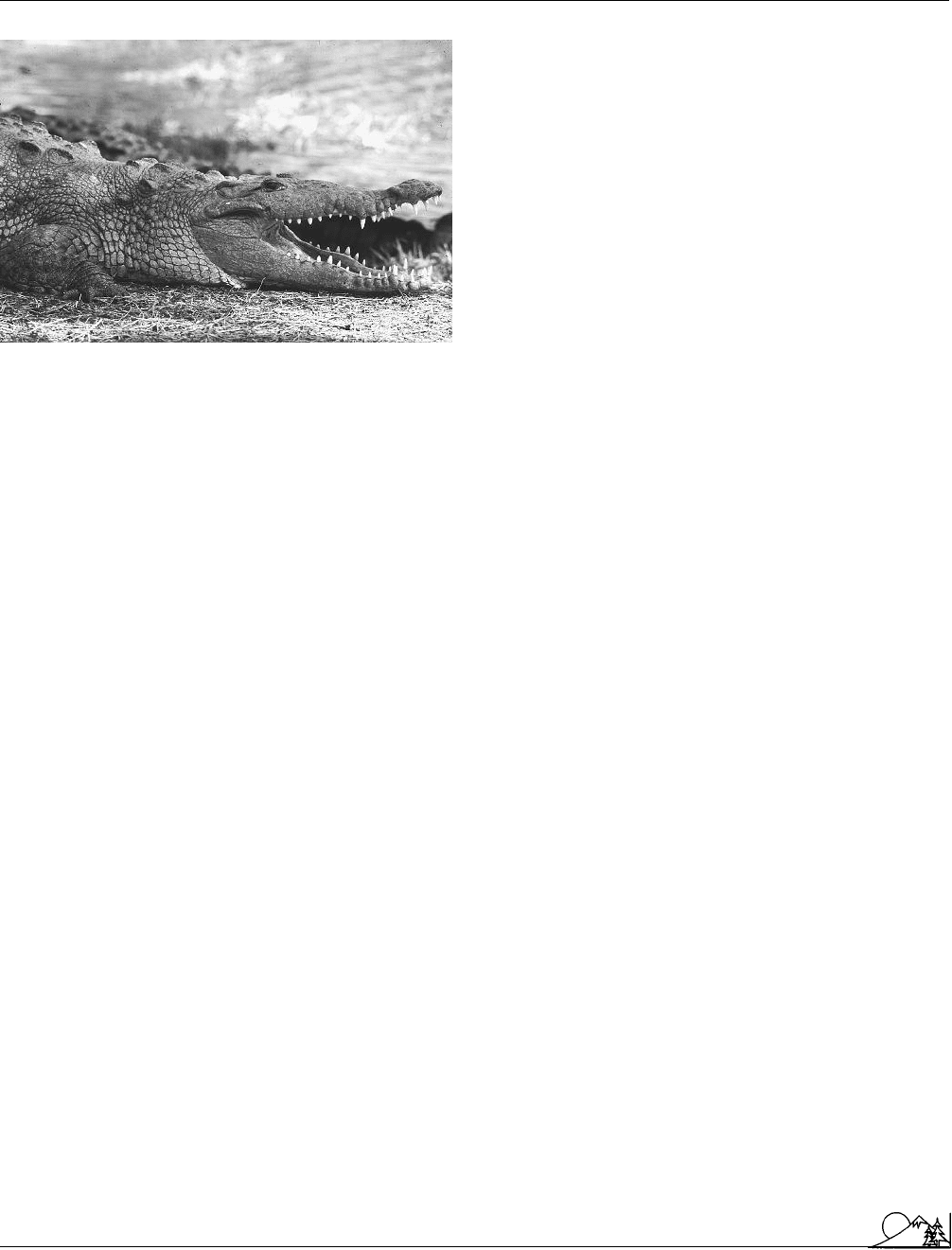Environmental Encyclopedia
Подождите немного. Документ загружается.


Environmental Encyclopedia 3
Cost-benefit analysis
A cost-benefit analysis. (McGraw-Hill Inc. Reproduced by permission.)
of animal
species
, and the impact of background contamina-
tion complicate these efforts. Under these conditions, simple
cause and effect statements are out of the question.
The most that can be said in health
risk assessment
is that exposure to a particular pollutant is likely to cause a
particular disease. Risk has to be stated in terms of probabili-
ties, not certainties, and has to be distinguished from safety,
which is a societal judgment about how much risk society
is willing to bear. When assessing the feasibility of techno-
logical systems, different types of risks—from mining, radia-
tion, industrial accidents, or
climate
impacts, for example—
have to be compared. This type of comparison further com-
plicates the judgments that have to be made.
Reducing risk involves asking to what extent the pro-
posed methods of reduction are likely to be effective, and
how much these proposed methods will cost. In theory,
decision making could be left to the individual. Society could
provide people with information and each person could then
decide whether to purchase a product or service, depending
upon the environmental and resource consequences. How-
ever, relying upon individual judgments in the market may
not adequately reflect society’s preference for an amenity
327
such as
air quality
, if that amenity is a public good with
no owner and no price attached to it. Thus, social and
political judgments are needed.
However much science reduces uncertainty, gaps in
knowledge remain. Scientific limitations open the door for
political and bureaucratic biases that may not be rational.
In some instances, politicians have framed legislation in ways
that seriously hinder if not entirely prohibit the consideration
of costs (as in the
Delaney Clause
and the
Clean Air Act
).
In other instances, of which the President’s
Regulatory
Review
Council is a good example, they have explicitly
required a consideration of cost factors.
There are different ways that cost factors can be con-
sidered. Analysts can carry out cost effectiveness analyses,
in which they attempt to figure out how to achieve a given
goal with limited resources, or they can carry out more formal
risk-benefit and cost-benefit analyses in which they have to
quantify both the benefits of risk reduction and the costs.
Economists admit that formal, quantitative ap-
proaches to balancing costs and benefits do not eliminate
the need for qualitative judgments. Cost-benefit analysis

Environmental Encyclopedia 3
Douglas M. Costle
initially was developed for water projects where the issues,
while complicated, were not of the same kind as society now
faces. For example, how does one assess the value of a
magnificent vista obscured by
air pollution
? What is the
loss to society if a given genetic strain of grass or animal
species becomes extinct? How does one assess the lost oppor-
tunity costs of spending vast amounts of money on air pollu-
tion that could have been spent on productivity enhancement
and global competitiveness?
The most recalcitrant question concerns the value of
human life. Cost-benefit analysis requires quantifying the
value of a human life in dollars, so that specific health risks
can be entered into the calculations against the cost of reduc-
ingsuch risks. Many different methodsof arriving at an appro-
priate figure have been undertaken, all with predictably absurd
results. Estimates range from $70,000 to several million dol-
lars a head. Although the question does not admit of a sensible
answer, society must nevertheless decide how much it is will-
ing to pay to save a given number of lives (or how much specific
polluters should pay for endangering them).
Equity issues (both interpersonal and intergenera-
tional) cannot be ignored when carrying out cost-benefit
analysis. The costs of air pollution reduction may have to
be borne disproportionately by the poor in the form of higher
gasoline
and
automobile
prices. The costs of
water pollu-
tion
reduction, on the other hand, may be borne to a greater
extent by the rich because these costs are financed through
public spending. Regions dependent on dirty
coal
may find
it in their interests to unite with environmentalists in seeking
pollution control
technology. The pollution control tech-
nology saves coal mining jobs in West Virginia and the
Midwest, where the coal is dirty, but draws away resources
from the coal mining industry in the West where large
quantities of clean-burning coal are located.
Intergenerational equity also plays a role.
Future gen-
erations
have no current representatives in the market sys-
tem or political process. How their interests are to be taken
into account ultimately amounts to a philosophical discus-
sion about altruism: to what extent should current genera-
tions hold back on their own consumption for the sake
of posterity? Should Jeremy Bentham’s utilitarian ideal of
“achieving the greatest good for the greatest number” be
modified to read “achieving sufficient per capita product
for the greatest number over time?” See also Environmental
economics; Intergenerational justice; Pollution control costs
and benefits; Risk analysis
[Alfred A. Marcus]
R
ESOURCES
B
OOKS
Buchholz, R., A. Marcus, and J. Post. Managing Environmental Issues.
Englewood Cliffs, NJ: Prentice-Hall, 1992.
328
Mann, D., and H. Ingram. “Policy Issues in the Natural Environment.”
In Public Policy and the Natural Environment, edited by H. Ingram and R.
K. Goodwin. Greenwich, CT: JAI Press, 1985.
Douglas M. Costle (1939 – )
American former director of Environmental Protection
Agency
An educator and an administrator, Douglas M. Costle
helped design the
Environmental Protection Agency
(EPA) under Richard Nixon and was appointed to the head
of that agency by Jimmy Carter. Costle was born in Long
Beach California on July 27, 1939, and spent most of his
teenage years in Seattle. He received his B.A. from Harvard
in 1961 and his law degree from the University of Chicago
in 1964. His career as a trial attorney in the civil rights
division of the Justice Department began in Washington in
1965. Later he became a staff attorney for the Economic
Development Administration at the Department of Com-
merce.
In 1969, Costle was appointed to the position of senior
staff associate of the President’s Advisory Council on Execu-
tive Organization, and in this post was instrumental in the
formation of the EPA. Although Costle lobbied to be ap-
pointed as assistant administrator of the new agency, his
strong affiliations with the Democratic party seem to have
hindered his bid. Instead he continued as a consultant to
the agency for two years and an adviser to the President’s
Council on Environmental Quality
.
The road that led Costle back to the EPA took him
to Connecticut in 1972, where he became first deputy com-
missioner and then commissioner of the Department of
Environmental Protection in that state. He proved himself
an able and efficient administrator there, admired by many
for his ability to work with industry on behalf of the
environ-
ment
. His most important accomplishment was the develop-
ment of a structure often called the “Connecticut Plan,”
where fines for industrial
pollution
were calculated on the
basis of the costs that business would have incurred if it had
complied with environmental regulations.
Carter appointed Costle head of EPA in 1977 as a
compromise candidate during a period of bitter feuding over
the direction of the agency (then at the center of a debate
over the economic effects of regulation). But many environ-
mentalists believed Costle’s record proved he compromised
too willingly with business, and they openly questioned
whether he had the political strength to support environment
protection in the face of fierce political and industrial oppo-
sition.
By May of his first year in office he was able to
secure funding for 600 additional staff positions in the
EPA, and under him much was done to provide a rationale

Environmental Encyclopedia 3
Council on Environmental Quality
for the regulations he had inherited and base them wherever
possible on scientific data. Among other decisions Costle
made while head of the EPA, he recommended a delay
on the imposition of new auto emissions standards, allowed
the construction of the nuclear plant in Seabrook, New
Hampshire to continue despite protests, and oversaw the
formation of an agreement with U.S. Steel on the reduction
of air and
water pollution
.
Throughout his tenure Costle remained a strong pro-
ponent of the view that the federal government’s responsibil-
ity to the environment was not incompatible with the obliga-
tions it had to the economy. He often argued that
environmental regulation actually assisted economic devel-
opment. Although conflicts with lobbying groups and hostile
litigation, as well as increased controversy over the inflation-
ary effects of environmental regulation, complicated his
stewardship of the EPA, Costle continued to believe in what
he called a gradual and “quiet victory” for environmental
protection.
Costle went on to become chairman of the U.S. Fed-
eral Regulatory Council until 1981. He is now a retired dean
of Vermont Law School in South Royalton.
[Douglas Smith]
R
ESOURCES
P
ERIODICALS
Langway, L., and J. Bishop Jr. “The EPA’s New Man.” Newsweek 89 (21
February 1977): 80–82.
Council on Environmental Quality
Until it was abolished by the Clinton Administration in
1993, the President’s Council on Environmental Quality
(CEQ) was the White House Office that advised the Presi-
dent and coordinated executive branch policy on the
envi-
ronment
. CEQ was established by the
National Environ-
mental Policy Act
(NEPA) of 1969 to “formulate and
recommend national policies” to promote the improvement
of the quality of the natural environment.
CEQ had three basic responsibilities: to serve as advi-
sor to the President on
environmental policy
matters; to
coordinate the positions of the various departments and
agencies of government on environmental issues; and to
carry out the provisions of NEPA. The latter responsibility
included working with federal agencies on complying with
the law and issuing the required regulations for assessing
the environmental impacts of federal actions. (NEPA re-
quires that all agencies of the federal government issue “a
detailed statement” on “the environmental impact” of “pro-
329
posals for legislation and other major federal actions signifi-
cantly affecting the quality of the human environment.” This
seemingly innocuous provision has been used often by envi-
ronmental groups to legally challenge federal projects that
might damage the environment, on the grounds that the
required
Environmental Impact Statement
was inadequate
or had not been issued.)
CEQ also prepared and issued the annual Environ-
mental Quality Report; administered the President’s Com-
mission on Environmental Quality, an advisory panel in-
volved in voluntary initiatives to protect the environment;
and supervised the President’s Environment and
Conserva-
tion
Challenge Awards, which honored individuals and or-
ganizations who achieved significant environmental accom-
plishments. Under the Nixon and Carter administrations,
CEQ had a significant impact on the formulation and imple-
mentation of environmental policy. But its role was greatly
diminished under the Reagan and Bush administrations,
which paid much less attention to environmental considera-
tions.
Perhaps CEQ’s best-known and most influential ac-
complishment was its landmark work, The Global 2000 Re-
port to the President, prepared with the U.S. Department of
State and other federal agencies, and released in July 1980.
This pioneering study was the first report by the U.S. govern-
ment—or any other—projecting long term environmental,
population, and resource trends in an integrated way.
Specifically, the report projected that the world of the
future would not be a pleasant place to live for much of
humanity, predicting that “if present trends continue, the
world in 2000 will be more crowded, more polluted, less
stable ecologically and more vulnerable to disruption than the
world we live in now. Serious stresses involving population,
resources, and environment are clearly visible ahead....the
world’s people will be poorer in many ways than they are
today.” CEQ’s Eleventh Annual Report, Environmental Qual-
ity—1980, further warned that “we can no longer assume,
as we could in the past, that the earth will heal and renew
itself indefinitely. Human numbers and human works are
catching up with the earth’s ability to recover...The quality
of human existence in the future will rest on careful steward-
ship and husbandry of the earth’s resources.”
In the following dozen years, CEQ was much more
reluctant to speak out about the ecological crisis. Early in
his presidency, Bill Clinton abolished CEQ and created the
White House Office on Environmental Policy to coordinate
the environmental policy and actions of his administration.
Clinton said this new body will “have broader influence and
a more effective and focused mandate to coordinate policy”
than CEQ had.
[Lewis G. Regenstein]

Environmental Encyclopedia 3
Jacques-Yves Cousteau
R
ESOURCES
P
ERIODICALS
“White House Environmentalists.” Buzzworm 5 (May-June 1993): 72.
O
THER
Environmental Quality: The Eleventh Annual Report of the Council on Envi-
ronmental Quality. Washington, DC: Council on Environmental Qual-
ity, 1980.
The Global 2000 Report to the President. Washington, DC: Council on
Environmental Quality, 1980.
O
RGANIZATIONS
Council on Environmental Quality, 722 Jackson Place, NW, Washington,
D.C. USA 20503 Fax: (202) 395-5750, Toll Free: (202) 456-6546, ,
<http://www.whitehouse.gov/ceq>
Jacques-Yves Cousteau (1910 – 1997)
French oceanographer, inventor, photographer, explorer,
and environmentalist
When most people think of marine biology, the person
that immediately comes to mind is Jacques-Yves Cousteau.
Whether through invention, research,
conservation
,ored-
ucation, Cousteau has brought the ocean world closer to
scientists and the public, and it is the interest, awareness,
and appreciation fostered through Cousteau’s work that may
ultimately save the marine
environment
from impending
destruction.
Born in France in 1910, Cousteau’s childhood was full
of illnesses that left him anemic. His sickness, however, did
not stop him from being an independent thinker, a trait that
led to his strong commitment to oceanographic research.
He attended the E
´
cole Navale in Brest, France, the national
naval academy, where his interest in marine research was
sparked by a cruise around the world on the school ship
Jeanne D’Arc. Cousteau brought his camera and filmed a
rough documentary of the voyage. His fascination with pearl
and fish divers, and his ability to use a camera, would revolu-
tionize undersea exploration.
During World War II, Cousteau, his wife, and two
friends made masks and snorkels from inner tubes and gar-
den hose. Through experimentation, they discovered that
the worst enemy of a diver was the cold, and Cousteau
proceeded to work on an effective diving suit. In 1943,
Cousteau and Emile Paul Gagnon patented the Aqua Lung,
the first self-contained underwater breathing apparatus
(SCUBA). It was this invention that led to Cousteau being
known as the “father of modern diving.” SCUBA has opened
a new world to scientific research as it is used extensively
not only in marine biology, but also in marine geology,
archaeology, and chemical oceanography.
Cousteau’s innovations did not end with the Aqua
Lung. He combined his interests in diving and photography
330
to develop the first underwater camera housing. While sta-
tioned with the Navy in Marseilles, Cousteau continued
to develop underwater photographic equipment, including
battery packs and lights. In 1943, Cousteau and several
friends filmed “Wrecks,” a documentary of a sunken ship
in the
Mediterranean Sea
. The French navy recognized
Cousteau’s talent and thought that this technology could be
useful in recovering German mines and retrieving lost cargo.
He was promoted to commandant and was put in charge
of the Undersea Research Group, where he continued to
develop diving and photographic techniques.
In 1950, Cousteau realized that the vessel donated to
the Undersea Research Group was inadequate and asked the
navy to furnish them with another ship. When the French
navy refused, Cousteau formed a non-profit organization,
Campagnes Oceanographique Franc
¸
aises, and was able to
raise enough money to purchase and refit an old British
minesweeper. This would become the most famous and
recognized scientific research vessel in the world: Calypso.
Cousteau first gained notoriety in the United States in
the early 1950s when Life Magazine and National Geographic
introduced Americans to the undersea endeavors of Cous-
teau and his Undersea Research Group. In 1953 Cousteau
was persuaded to translate his journals into English and
published them as The Silent World. It sold five million
copies and was translated into twenty-two languages. It was
filmed as a documentary in 1955 and won an Academy
Award and the Gold Medal at the Cannes Film Festival
that year. Following the commercial success of his film,
Cousteau was appointed director of the world’s oldest and
largest marine research center, the Oceanographic Institute
of Monaco. He rebuilt the deteriorating institute, adding
aquariums and many live specimens collected during his
travels.
While trying unsuccessfully to house
dolphins
in the
facility, Cousteau developed a respect for the intelligence of
these animals. This prompted him to campaign for stopping
the slaughter of dolphins for use in pet foods. This was to
be the first of many environmental campaigns for Cousteau,
during which he discovered that the public, once educated
about the environment, would be willing to try to preserve
it. This theme of education has guided
the Cousteau Soci-
ety
, and many other environmental organizations, ever since.
Exploring depths deeper than possible with SCUBA
intrigued Cousteau and, in 1960, he tested the DS-2 diving
saucer, in which he dove to over 984 ft (300 m) in the Bay
of Ajaccio, near Corsica. After hundreds of successful dives,
Cousteau started Continental Shelf Station Number One
(Conshelf I) in the Mediterranean. This experiment not
only investigated deep undersea habitats, but also determined
how divers would respond to life underwater for long periods
of time while conducting laboratory experiments. The work

Environmental Encyclopedia 3
Cousteau Society, The
Jacques Cousteau. (Corbis-Bettmann. Reproduced by
permission.)
performed by Cousteau and his research group not only laid
the groundwork for all subsequent submersible engineering
and exploration, but also was one of the first thorough inves-
tigations of hyperbaric physiology.
In 1966, Cousteau began that for which he is best
known: television documentaries. With the airing of “The
World of Jacques Cousteau,” millions were introduced to
the wonders of the sea. That same year, Cousteau signed a
contract and began to film “The Undersea World of Jacques
Cousteau,” which ran for nearly nine years, giving Americans
a glimpse of marine environments and the behaviors of the
organisms that live there. The series, now in syndication,
continues to fascinate generations of Americans and spawn
interest in marine science and conservation.
In the early 1970s, Cousteau became frustrated with
increasing
marine pollution
and produced a series of docu-
mentaries focusing on the destruction of marine systems.
He also expanded his explorations to riverine systems, lakes,
rain forest
destruction and the conflicts between human
culture and the environment. The scope of his films demon-
strates Cousteau’s devotion to preserving all natural systems.
Cousteau’s accomplishments are numerous. He had
published more than 18 books and contributed many articles
to professional and popular journals. His documentary films
have won three Academy Awards and his series, “The Un-
331
dersea World of Jacques Cousteau,” has won numerous
Emmy Awards. Many organizations have recognized Cous-
teau for his work in technical fields as well as in conservation.
These awards include Gold Medals from the National Geo-
graphic Society and the Royal Geographical Society, and
the United Nations international environmental award. He
has received honorary degrees from the University of Califor-
nia at Berkeley, Brandeis University, Rensselaer Polytechnic
Institute, Harvard University, the University of Ghent, and
the University of Guadalajara. He was named to the U.S.
National Academy of Sciences
in 1968.
Cousteau’s devotion to the natural world has not been
with out its costs. His son Philippe was killed in a diving
accident and numerous financial difficulties, especially early
in his career, set back his work. Whether it is in oceano-
graphic research, marine engineering, the development and
manufacture of diving equipment, the production of films
and television specials, or
environmental education
, Cous-
teau continued to inspire and fascinate, motivating scientists
and the public alike to work to preserve the ocean world
until his death Paris on July 25, 1997.
[William G. Ambrose Jr. and Paul E. Renaud]
R
ESOURCES
B
OOKS
Cousteau, J-Y. The Cousteau Almanac: An Inventory of Life on Our Water
Planet. New York: Doubleday, 1981.
Munson, R. Cousteau: The Captain and His World. New York: Morrow,
1989.
Cousteau Society, The
The Cousteau Society is a non-profit organization dedicated
to marine research, especially underwater exploration and
filmmaking. Created in 1973 by
Jacques-Yves Cousteau
and his son, Jean-Michel Cousteau, the Society provides
educational materials, and sponsors or cosponsors scientific,
technological and environmental research studies to gauge
the health of the world’s marine environments.
The Society’s educational projects include award-win-
ning television specials that inspire interest in the marine
world. Special reports filmed and broadcast have included
those on the
Exxon Valdez
oil spills and the natural history
of the great white shark (Carcharodon charcharias). Cous-
teau films are broadcast in more than 100 countries and to
schools around the world. Books and filmstrips on marine
and environmental issues are produced for colleges, schools,
and the public. The Society produces two periodicals that
explain scientific and environmental issues, the Calypso Log
for adults and the Dolphin Log for youngsters.

Environmental Encyclopedia 3
Coyote
The Society’s Project Ocean Search offers field study
programs under the supervision of Society educators and
scientists. Presently, the Society is developing Cousteau
Center sites that will provide visitors with ocean experiences
through the use of film and illusion technology. The Society
also sponsors research to help the scientific community better
understand the nature of a region or phenomenon, as well
as studies designed to provide local policy makers with guide-
lines to protect their
environment
.
Two Cousteau Society research vessels, Calypso and
Alcyone, are circumnavigating the globe to take a fresh look
at the planet. Four hours of television documentaries are
filmed each year about those expeditions. Scientific teams
aboard the two research vessels are measuring the productiv-
ity of the oceans, studying the contributions of rivers to
ocean vitality, assessing the health of marine and freshwater
habitats, and exploring the global connections between major
components of the
biosphere
such as tropical forests, rivers,
the
atmosphere
, seas, oceans, and humankind.
The Society also provides assistance to the Marine
Mammal Stranding Program, a network of scientists and
others who study strandings of
whales
and
dolphins
. With
the Smithsonian Institution, the Society sponsors the Marine
Mammal Events Program, which gathers information on
beach stranding reports from the United States and other
parts of the world to create a centralized data base. The
compilation is expected to lead to a better understanding of
the phenomenon of beaching.
Currently, the Society is developing educational com-
puter programs for young people that explore the conse-
quences of various actions on the environment; and it is
preparing environmental cartoon books for students in devel-
oping countries. It also supports the development of new
technologies that will help provide solutions to environmen-
tal challenges.
[Linda Rehkopf]
R
ESOURCES
O
RGANIZATIONS
The Cousteau Society, 870 Greenbrier Circle, Suite 402, Chesapeake,
VA USA 23320 (800) 441-4395, Email: cousteau@cousteausociety.org,
<http://www.cousteausociety.org>
Coyote
The name coyote comes from the Aztec name Coyoti. The
Latin name for the coyote is Canis latrans which means
barking dog. A member of the family Canidae, the coyote
is also called God’s Dog, brush wolf,
prairie
wolf, and the
Songdog.
332
Coyotes are especially important to biologists and
others studying
wildlife
and the
environment
both because
of their ability to control their own population and because
of their effect upon other wildlife populations, especially
that of the white-tailed deer.
The coyote is roughly the size of a small German
Shepherd, weighing from 20–35 lb (9–14 kg) and 4–5 ft
(1.2–1.5 m) long, although some can grow as large as 50
lb (23 kg) in the northern and northeastern part of their
range. The coat of a coyote can be gray or brownish gray,
depending on the season and
habitat
, with a bushy tail
that is tipped with black. Coyote fur is long and soft and
grows heavier in the winter to protect it from the cold.
Its fur also grows lighter in color in the winter and darker
in the summer to help it blend in with its natural
surroundings.
The early European settlers originally found the coyote
only in Central and western North America. However, de-
spite many attempts by humans to get rid of them, coyotes
today range from Panama to Northern Alaska, and from
California to Newfoundland. They have been seen in every
state in the continental United States, but since they are
predominately nocturnal, are too elusive to count accurately.
Coyotes have even been found in isolated regions such as
Cape Cod, as well as in various urban areas such as Chicago,
Los Angeles, and New York City.
This ongoing expansion of the coyote’s range began
in the late 1800s, soon after the United States government
began programs of killing them in order to protect domestic
livestock, especially the sheep that were
grazing on public
lands
. However, unlike the
overhunting
of other
species
,
such as the passenger pigeons, grizzly bears,
wolves
, and
whales
, the best efforts to kill off the coyotes have all failed,
and coyotes have continued to thrive. Biologists now believe
that the coyote population has more than doubled since
1850.
Several factors account for this expansion. Farming
and the clearing of the unbroken forests that once covered
much of North America have created new and more
suitable habitats. The eradication of the wolf in much of
North America has removed one of the coyote’s major
predators and has led to less
competition
for many prey
animals. Unlike the wolf, the coyote has more easily
adapted to changing habitats, and has adjusted to living
close to human populations. In addition, the introduction
of sheep and other domestic animals has given the coyote
new food sources.
Coyotes are opportunistic carnivores with a variable
diet depending on the season or habitat. Although they
prefer rodents, rabbits, and hares, they are definitely not
picky. They will emulate the larger wolf and hunt deer, elk,
and sheep in packs. They will also eat carrion and have been

Environmental Encyclopedia 3
Coyote
known to eat grasshoppers, beetles, snakes, lizards,
frogs
,
rats, domestic cats, porcupines, turtles, and even watermel-
ons and wild blueberries.
Coyotes are one of the most vocal animals of the
wild. Through a series of howls, yelps and barks, coyotes
communicate to other coyotes in the area, with others in
their pack, and with their young.
Studies of the coyote’s breeding patterns have shown
that they are able to control their own population. To do
this the coyote relies upon various breeding strategies. If
there are too many coyotes for the food supply, they will
continue to mate and have young, but only enough pups
will be born and will survive to replace those that have died.
However, if they are not being overhunted and if there is
plenty of food, there will be more pups born in each litter
and the number that will survive into adulthood will increase.
Because of this innate ability to vary their own popula-
tions, coyotes have thrived and play a central role in main-
taining the overall ecological balance. Extensive studies of
the coyote have shown the crucial interaction between them
and many other species, both predator and prey. When the
jackrabbit population decreases, as it does periodically in the
Curlew Valley of Idaho and Utah for example, the coyote
population decreases also, usually within the following year.
Then, when the jackrabbit population increases again, coy-
otes become more numerous also.
Coyotes mate for life and the adults breed between
January and March. The female maintains the den that she
selects from an old badger or woodchuck hole, or a natural
cavity in the ground. The female carries her young for over
two months, giving birth in April or May. A litter may have
from two to 12 pups.
Both parents play an active role in raising the pups.
At three weeks old the pups are allowed to leave the den to
play and by 12 weeks old they are taught to hunt. The family
stays together through the summer but by fall the pups will
leave to find their own territories. The survival rate for these
pups is low. Between 50 and 70% die before they reach
adulthood. Eighty percent of those deaths are due to man.
Coyotes limit the populations of various smaller preda-
tors, by preying upon them directly or by competing with
them for prey. This in turn indirectly affects various prey
communities, especially those of birds. When there are no
coyotes to keep them in check, the smaller predators expand
and are able to kill off a larger segment of the various bird
populations.
The coyote and the deer populations interact in an
important way as well. Whenever the coyote population
decreases, the deer population, particularly that of the white-
tailed deer, increases, leading to unhealthy herds and, ac-
cording to some biologists, to an increase in Lyme disease-
bearing ticks in some regions. Coyotes are thus a major
333
A coyote. (© U. S. Fish & Wildlife Service. Reproduced
by permission.)
factor in maintaining healthy deer populations and in pre-
venting the spread of a disease that is dangerous and poten-
tially fatal to humans.
Coyotes affect humans more directly as well, especially
through their impact upon domestic animals. Since Europe-
ans first came to North America, coyotes have preyed upon
sheep and other livestock, costing sheep growers, farmers,
and ranchers untold millions of dollars. In some areas, live-
stock may make up 14% of a coyote’s diet. This has prompted
extensive
hunting
to control the number of coyotes that
ranchers and farmers view as pests. Some ranchers keep
guard dogs to protect their livestock. New technology, using
inaudible ultrasonic sound, also allows ranchers to detect or
repel coyotes.
Although there are no documented cases of humans
dying from coyote attacks, coyotes will fiercely defend them-
selves if cornered. However, they are much less dangerous
than wild domestic dogs, which have killed more than 300
people in the decade since 1990. Coyotes can coexist with
humans. But can people learn to live with them? Humans
cause 90% of all adult coyote deaths by hunting,
trapping
,
poisoning
, and
automobile
accidents. Wolves, black bears,
mountain lions, and eagles, as well as various
parasites
and
diseases, account for the rest.
[Douglas Dupler]

Environmental Encyclopedia 3
Criteria pollutant
R
ESOURCES
B
OOKS
Dobie, J. Frank. The Voice of the Coyote. Boston: Little, Brown and Co., 1949.
Leydet, Francois. The Coyote: Defiant Songdog of the West. Norman, OK:
University of Oklahoma Press, 1988.
P
ERIODICALS
Finkel, Mike. “Ultimate Survivor.” Aubudon, May-June 2002.
Foderaro, Lisa W. “Letting Golf Courses Go a Little Wild; Clubs Spray
Less and Make Way For Native Plants and Coyotes.” New York Times,1
May 2002.
Gompper, Matthew E. “Top Carnivores in the Suburbs? Ecological and
Conservation Issues Raised by Colonization of North-Eastern North
America by Coyotes.” BioScience, February 2002, 185–191.
Gregory, Ted. “Hot on the Trail of Nomadic Urban Coyotes.” Chicago
Tribune, 12 May 2002, 1.
Grinder, Martha I. and Paul R. Krausman. “Home Range, Habitat Use,
and Nocturnal Activity of Coyotes in an Urban Environment.” Journal of
Wildlife Management, 65, no. 4 (2001): 887–99.
O
THER
Desert Usa. The Coyote, Canis latrans. [2002]. <http://www.desertusa.com>.
Senecal, D. “Coyote, Hinterland Who’s Who.” Canadian Wildlife Service.
[2002]. <http://www.cws-scf.ec.gc.ca>.
Crane (bird)
see
Whooping crane
Creutzfeldt jacob disease
see
Mad cow disease
Criteria pollutant
Criteria pollutants are air pollutants which, at certain levels of
exposure, do not threaten human health and meet National
Ambient Air Quality Standards. There are two types of
standards for such pollutants. National primary ambient
air
quality
standards are levels of air quality with a margin of
safety adequate to protect public health. National secondary
ambient air quality standards are levels of air quality which
are necessary to protect the public welfare from any known
or anticipated adverse effects of a pollutant. See also Air
Quality Control Region; Air quality criteria; Primary stan-
dards; Secondary standards
Critical habitat
As institutionalized in the U. S.
Endangered Species Act
of 1973, critical
habitat
is considered the area necessary to
the survival of a
species
, and, in the case of endangered and
threatened species, essential to their recovery. An animal’s
habitat includes not only the area where it lives, but also its
334
breeding and feeding grounds, seasonal ranges, and
migra-
tion
routes. Critical habitat usually refers to the area that is
essential for a minimal viable population to survive and
reproduce. The
Endangered Species
Act is intended to
conserve “the ecosystems upon which endangered species
and threatened species depend.” Thus, the Secretary of the
Interior is required to identify and designate critical habitats
for species that are listed as endangered or threatened under
this law. In some cases, areas may be excluded from such
designations if the economic, social, or other costs exceed
the
conservation
benefits.
The listing of imperiled species and the designation
of their critical habitats have become politically sensitive,
since these actions can profoundly affect the development
and exploitation of areas so designated, and can, under some
circumstances, limit such activities as gas and
oil drilling
,
timber cutting, dam building, mineral exploration and min-
ing. For this and other reasons, the Department of the
Interior often has been reluctant to list certain species, and
has excluded species from the protected lists in order not to
inconvenience certain commercial interests.
Section 7 of the Endangered Species Act requires all
federal agencies and departments to ensure that the activities
they carry out, fund, or authorize do not jeopardize the
continued existence of listed species or adversely modify
or destroy their critical habitat. This provision has proven
especially significant, since federal agencies such as the
For-
est Service
,
Bureau of Land Management
, and
Fish and
Wildlife Service
control vast areas of land that constitute
habitat for many listed species and on which a variety of
commercial activities, such as
logging
or mining, are under-
taken with federal permits.
However, Section 7 of the Endangered Species Act
has been implemented in such a way as to generally not
affect economic development. The U. S. Fish and Wildlife
Service (and, in the case of marine species, the National
Marine Fisheries Service) is directed to consult with other
federal agencies and review the effects of their actions on
listed species. According to a study by the
National Wildlife
Federation
, over 99% of the more than 120,000 reviews or
consultations conducted between 1979 and 1991 found that
no jeopardy to a listed species was involved. In some cases,
“economic and technologically feasible” alternatives and
modifications, in the words of the act, were suggested that
allowed the federal activities to proceed. In only 34 cases
were projects cancelled because of threats to listed species.
In rare situations, where the conflict between a project and
the Endangered Species Act are absolutely irreconcilable, an
agency can apply for an exemption from a seven-member
Endangered Species Committee.
The earliest major conflict over critical habitat under
the Act was the famous 1979 fight over construction of the

Environmental Encyclopedia 3
Crocodiles
$116 million
Tellico Dam
in Tennessee, which would have
flooded and destroyed several hundred family farms as well
as what was then the only known habitat of a species of
minnow, the
snail darter
(Percina tanasi). (Since then, snail
darters have been found in other areas.) Congress exempted
this project from the provisions of the Endangered Species
Act, and the dam was built as planned, although many
consider it a political boondoggle and a huge waste of taxpay-
ers’ money.
More recently, efforts by environmentalists to save the
remnants of
old-growth forest
in the Pacific Northwest
to preserve habitat for the
northern spotted owl
(Strix
occidentalis caurina) created tremendous controversy. Thou-
sands of acres of federally-owned forests in Oregon, Wash-
ington, and California were placed off-limits to logging,
costing jobs in the timber industry in those states. However,
conservationists pointed out, if the federal government al-
lowed the last of the ancient forests to be logged, timber jobs
would disappear anyway, along with these unique ecosystems
and several species dependent upon them. In mid-1993,
Interior Secretary announced a compromise decision that
allows logging of some ancient forests to continue, but also
greatly decreases the areas open to this activity. As natural
areas and wildlife habitat continue to be destroyed and de-
graded, conflicts and controversy over saving critical habitats
for listed endangered and threatened species can be expected
to continue.
[Lewis G. Regenstein]
R
ESOURCES
B
OOKS
Bean, M. J., et al. Reconciling Conflicts Under the Endangered Species Act:
The Habitat Conservation Planning Experience. Washington, DC: World
Wildlife Fund, 1991.
Kohm, K., ed. Balancing on the Brink of Extinction: The Endangered Species
Act and Lessons for the Future. Covelo, CA: Island Press, 1990.
Crocodiles
The largest of the living reptiles, crocodiles inhabit shallow
coastal bodies of water in tropical areas throughout the world,
and they are often seen floating log-like in the water with
only their eyes and nostrils showing. Crocodiles have long
been hunted for their hides, and almost all
species
of croco-
dilians are now considered to be in danger of
extinction
.
Members of the crocodile family, called crocodilians (Croco-
dylidae), are similar in appearance and include crocodiles,
alligators, caimans, and gavials. A crocodile can usually be
distinguished from an alligator by its pointed snout (an
alligator’s is rounded), and by the visible fourth tooth on
either side of its snout that protrudes when the jaw is shut.
335
Crocodiles prey on fish, turtles, birds, crabs, small
mammals, and any other animals they can catch, including
dogs and occasional humans. They hide at the shore of rivers
and water holes and grab an animal as it comes to drink,
seizing a leg or muzzle, dragging the prey underwater, and
holding it there until it drowns. When seizing larger animals,
a crocodile will thrash and spin rapidly in the water and tear
its prey to pieces. After eating its fill, a crocodile may crawl
ashore to warm itself and digest its food, basking in the sun
in its classic “grinning” pose, with its jaws wide open, often
allowing a sandpiper or plover to pick and clean its teeth by
scavenging meat and
parasites
from between them.
The important role that crocodiles play in the
balance
of nature
is not fully known or appreciated, but, like all
major predators, their place in the ecological chain is a crucial
one. They eat many poisonous water snakes, and during
times of
drought
, they dig water holes, thus providing water,
food, and
habitat
for fish, birds, and other creatures. When
crocodiles were eliminated from lakes and rivers in parts of
Africa and
Australia
, many of the food fish also declined
or disappeared. It is thought that this may have occurred
because crocodiles feed on predatory and scavenging species
of fish that are not eaten by local people, and when left
unchecked, these fish multiplied out of control and crowded
out or consumed many of the food fish.
Crocodiles reproduce by laying eggs and burying them
in the sand or hiding them in nests concealed in vegetation.
Recent studies of the Nile and American crocodiles show
that some of these reptiles can be attentive parents. Ac-
cording to these studies, the mother crocodile carefully
watches over the nest until it is time for the eggs to hatch.
Then she digs the eggs out and gently removes the young
from the shells. After gathering the newborns together, she
puts them in her mouth and carries them to the water and
releases them, watching over them for some time. American
crocodiles are very shy and reclusive, and disturbance during
this critical period can disrupt the reproductive process and
prevent successful hatchings.
In recent decades, crocodiles and other crocodilians
have been intensively hunted for their scaly hides, which
are used to make shoes, belts, handbags, wallets, and other
fashion products. As a result, they have disappeared or have
become rare in most of their former habitats. As of 2001,
12 crocodile species have been designated endangered. These
species are found in Africa, the Caribbean, Central and
South America, the Middle East, the Philippines, Australia,
some Pacific Islands, southeast Asia, the Malay Peninsula,
Sri Lanka, and Iran. They are endangered primarily due to
overexploitation and habitat loss.
The American crocodile (Crocodylus acutus) occurs all
along the Caribbean coast, including the shores of Central
America, Colombia, Cuba, Hispaniola, Jamaica, Mexico,

Environmental Encyclopedia 3
William Cronon
An American crocodile. (Photograph by Tom and Pat
Leeson. Photo Researchers Inc. Reproduced by per-
mission.)
extreme south Florida, and on the Pacific coast, from Peru
north to southern Mexico. The United States population of
the American crocodile consists of some 500–1,2000 indi-
viduals. This species breeds only in the southern part of
Everglades National Park
, mainly Florida Bay, and per-
haps on nearby Key Largo, and at Florida Power and Light
Company’s Turkey Point plant, located south of Miami.
The population is thought to be extremely vulnerable and
declining, mainly due to human disturbance, habitat loss
(from urbanization, especially real estate development), and
direct killing such as on highways and in fishing nets. Preda-
tion of hatchlings in Florida Bay mainly by raccoons may
also be a factor in the species’ decline.
[Lewis G. Regenstein]
R
ESOURCES
B
OOKS
Crocodiles: Their Ecology, Management and Conservation. A Special Publication
of the Crocodile Specialist Group. Gland, Switzerland: IUCN-The World
Conservation Union, 1989.
Ross, C. A., ed. Crocodiles and Alligators. New York: Facts on File, 1989.
Thorbjarnarson, J., comp. Crocodiles. An Action Plan for Their Conservation.
Gland, Switzerland: IUCN-The World Conservation Union, 1992.
William Cronon (1954 – )
American Frederick Jackson Turner Professor of History,
Geography, and Environmental Studies, University of Wis-
consin
William Cronon is an environmental historian, and the au-
thor of several notable books on
wilderness
, American
landscape, and history. Cronon grew up in Madison, Wis-
336
consin and did his undergraduate work at the University of
Wisconsin. He won a Rhodes scholarship and spent two
years studying at Oxford University, earning a doctorate.
His first book, Changes in the Land: Indians, Colonists and
the Ecology of New England, was published in 1983. This
book was cited by reviewer Jim Miller in Newsweek as an
“eloquent book” with “the rigor of first-rate history and the
power of a tragedy.” The book’s tragic power lies in its
subject-the destruction of the fertile
habitat
of pre-colonial
New England by the colonists’ farming methods and exploi-
tation of
natural resources
, and the virtual eradication of
the native American population by diseases brought from
Europe by the colonists. Cronon supports his explication of
this devastation with evidence gathered from such sources
as original Puritan documents and the literature of
ecology
and anthropology. His next book was Nature’s Metropolis:
Chicago and the Great West, published in 1991. This work
extended Cronon’s investigation of the way human beings
shape landscape, looking at relationships between nineteenth
century Chicago and the land around it.
Cronon left a tenured position at Yale in order to take
up a post at the University of Wisconsin in 1992, returning
to his home town. He put out several more books in the
1990s, including Under an Open Sky: Rethinking America’s
Western Past, and Uncommon Ground: Rethinking the Human
Place in Nature, and editing a book of John Muir’s
nature
writings. Cronon’s writings have challenged other environ-
mentalists’ conception of wilderness as a pristine place un-
touched by man. His work focuses on the inextricable rela-
tionship between human civilization and nature. Idealizing
wilderness as something apart from humankind for Cronon
stands in the way of clear thinking about how to preserve
the
environment
. For example Cronon wrote about the
Arctic National Wildlife Refuge
in 2001, when the incom-
ing Bush administration sparked renewed calls to drill for
oil in the nature preserve. Cronon argued that the word
wilderness conjured up for most people a “place remote from
human settlements, untouched by human hands.” The Arctic
National Wildlife Refuge
was in fact deeply tied to human
civilization as a holy place to Alaskan Indians, a breeding
ground for their caribou, and a migratory stop for birds found
in 49 out of 50 states in the U.S. The Alaskan wilderness was
neither as empty nor as distant as it seemed. Pointing out
the many complex relationships between human communi-
ties and the land surrounding them is the core of Cro-
non’s work.
[Angela Woodward]
R
ESOURCES
P
ERIODICALS
“An Environmentalist on a Different Path” New York Times (April 3, 1999):
B7, B9.
